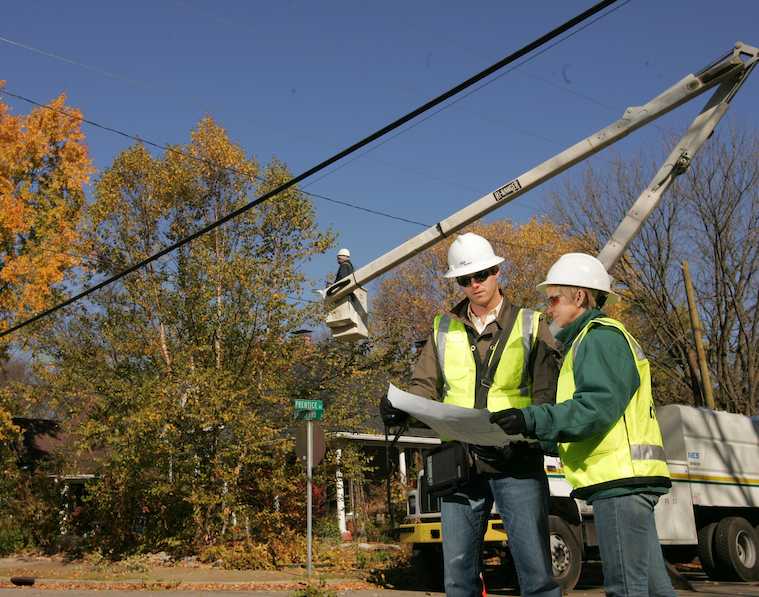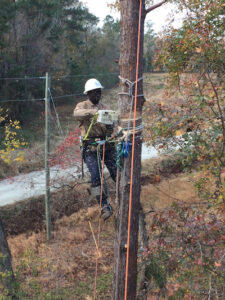Clearing Up Incidental Line Clearance

By Kevin Myers
This past fall saw some significant changes to one of the most important safety documents for arborists across the industry: The ANSI Z133 Safety Standard.
The changes debuted in November at the annual Tree Care Industry Association show in Columbus, and make up the first significant revision to the standard in five years. Some of the highlights include a mandatory requirement for arborists to carry handsaws while working aloft; a new requirement for two-wheel chocks for bucket trucks; and the necessity for two workers on a crew to be trained in CPR and first aid.
 One of the most significant individual changes, though, was made to the standard’s section on Electrical Hazards. Those rules are now divided into three classifications, including General, Incidental Line Clearance, and Utility Line Clearance.
One of the most significant individual changes, though, was made to the standard’s section on Electrical Hazards. Those rules are now divided into three classifications, including General, Incidental Line Clearance, and Utility Line Clearance.
Incidental Line Clearance is a new addition, and has raised some questions among working arborists with whom I’ve worked. Namely, “Which classification do I fall under?”
In the past, arborists were either qualified to work around energized conductors, or they weren’t. Qualified and unqualified arborists would then follow two different sets of rules governing minimum approach distances to electrical hazards.
In the 2017 update, this remains largely the same; you are either qualified, or you are not, based on your training and experience. But now, qualified arborists belong to one of two categories: Incidental Line Clearance or Utility Line Clearance.
What’s the difference? Either you’re coming in contact with electrical hazards as an incidental part of your job, or you’re specifically and regularly working around electrical hazards as employed by or contracted with a utility.
Incidental line clearance is defined as “tree work performed where an electrical hazard exists to the arborist, but the arborist is not working for the purpose of clearing space around the conductor on behalf of the utility that controls or operates the wires/lines.” So, for example: A municipal arborist who is pruning or removing street trees along roadways, or general arborists who may encounter the occasional service drop running through a tree in need of pruning would typically fall into the Incidental Line Clearance definition.
In any case, as stated in section 4.2.4 of the 2017 revision of the Z133, the individual under the Incidental Line Clearance classification still requires a minimum amount of training and experience to be considered as qualified. Here’s the language, right from the book:
4.2.4 Training for qualification of qualified Incidental Line Clearance Arborists requires a minimum of:
(a) the skills and techniques necessary to distinguish exposed live parts from other parts of electric equipment;
(b) the skills and techniques necessary to determine the nominal voltage of exposed live parts; and
(c) the minimum approach distances (MAD) specified in Table 2 and the corresponding voltages to which the qualified person will be exposed.
Within the new rules, MAD for non-qualified individuals are found in Table 1; Incidental Line clearance MAD are found in Table 2; and MAD for Utility Line Clearance are found under Table 3 (below).
For the arborist, the formal distinction between Incidental Line Clearance and Utility Line Clearance has primarily to do with his or her employer. If you are not working for a utility, or you are not contracted by a utility for clearing vegetation from electrical conductors to maintain the safety and reliability of the electrical infrastructure, then you are not a Utility Line Clearance Arborist.
Under the Utility Line Clearance classification, the host utility has given the arborist explicit permission to work around their conductors, along with training in that utility’s safety and operations protocols. Under the Incidental Line Clearance classification, the arborist is working around a utility’s conductors without the utility’s knowledge or permission, and there is no direct relationship between the arborist and the utility.
Further, Incidental Line Clearance arborists, though they may have sufficient training and experience, are not ordinarily working within close proximity of energized conductors. This arborist’s level of awareness simply won’t be the same of that of a Utility Line Clearance arborist, who works around electrical hazards on a daily basis. To compensate for that daily experience gap, the MAD for the Incidental Line Clearance arborist is greater than that for a Utility Line Clearance Arborist.
Finally, there’s one addition to the language here, which comes straight from OSHA 1910.269:
4.1.3 Arborists’ training and degree of training in electrical hazards shall be determined by the risk to the employee for the hazard(s) involved.
The paragraph above puts direct responsibility on employers to be sure that they are providing their employees with the appropriate training and amount of training in electrical hazards, based on the work that they do. Whether or not you are certified can only be determined by your employer, because ultimately they are the one who will be held responsible if you get shocked or electrocuted on the job.
For more information on Line Clearance arboriculture and to find out if you are qualified, I encourage you to read the Occupational Safety and Health Administration (OSHA) rules on the subject, found under the 29 CFR standard, section 1910.269. I’d also encourage any and all professional arborists to read the revised ANSI Z133.
Kevin Myers, CTSP, ISA-certified arborist and ISA-certified Utility Specialist, is an arborist training instructor with ACRT, and a recipient of the 2016 UAA Silver Shield Award. For more information, visit www.acrt.com. If you or your company are interested in line clearance training, visit the new ACRT Arborist Training website at training.acrt.com.
Photos and tables provided by ACRT.






